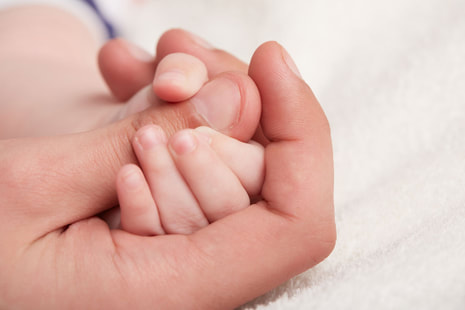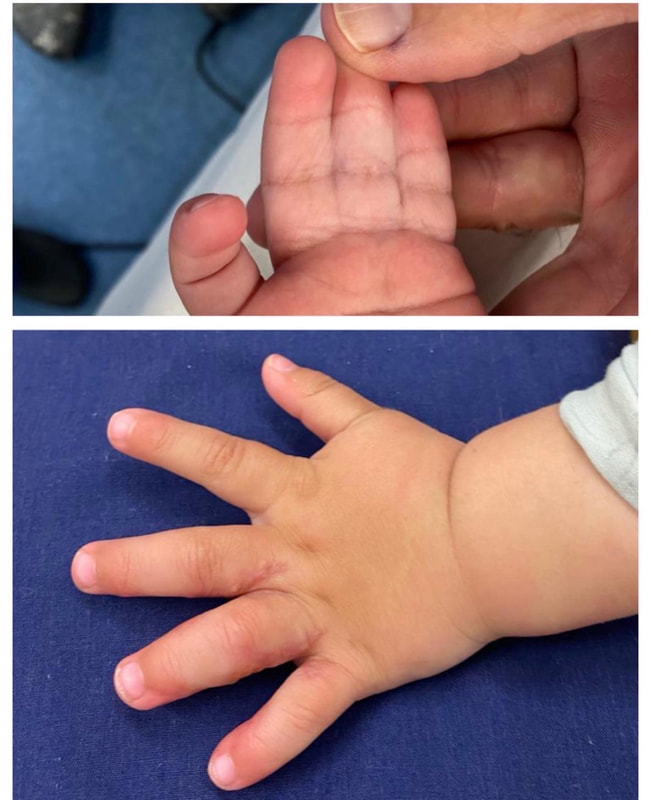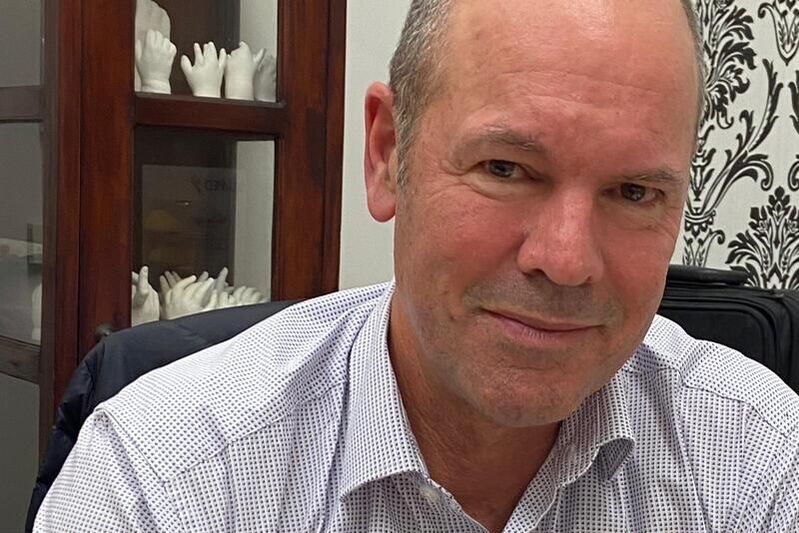Above image not a patient.
Dr Lewis Blennerhassett - 25 years experience
CONGENITAL HAND DIFFERENCES TREATED - polydactyly, syndactyly, hypoplasia, symbrachydactyly, cleft hand, aplasia, radial club hand, ulnar club hand, macrodactyly, constriction ring syndrome, clinodactyly, camptodactyly, trigger thumb
|
Little hands have a big role to play in your child’s life as they grow. They are important for feeding, learning, exploring, gaining individual freedoms – but most of all playing and having fun.
Perth congenital hand surgeon Dr Lewis Blennerhassett has worked with many WA families – sometimes from the first few days after birth – to optimise form and function with their children’s hands. Some of these young patients required a one-off surgical procedure, for others it involved several years of planning, surgery and operations to address function issues from congenital hand differences. Adults who were not offered surgery as a child have also undergone surgery with Dr Blennerhassett. |
Perth congenital hand surgeon - Dr Lewis Blennerhassett
Dr Blennerhassett is a leading Perth hand surgeon performing children’s congenital hand differences surgery at private hospitals and Perth Children’s Hospital. He has more than 25 years experience in paediatric hand surgery, including performing Syndactyly surgery, Polydactyly surgery, Camptodactyly surgery and Hypoplasia surgery, as well as other less common congenital conditions.
He has trained extensively in hand surgery, including working closely with complex hand surgery expert Dr Joseph Upton, who is a clinical professor of surgery at Harvard Medical School in the USA and author of 250 articles and 60 book chapters on hand surgery.
Dr Blennerhassett’s reconstructive skills from his additional plastic surgery training ensures that his hand surgery is focused on being meticulous and precise, prioritising safety and quality.
He is experienced and skilled in microsurgery, a surgical procedure that involves using a high-powered microscope during an operation to repair tiny blood vessels and nerves – some only a few millimetres in diameter or as small as a human hair.
He has also worked for several decades at Perth’s major paediatric teaching hospital and been on call 24/7 to surgically repair hand injuries and treat disorders. The youngest patient he has operated on was only a few days old.
Thumbs and pollicisation surgery
Thumb underdevelopment (hypoplasia) accompanies many congenital hand differences.
Dr Blennerhassett has surgically created thumbs for around 100 WA children born without thumbs.
Dr Blennerhassett is a leading Perth hand surgeon performing children’s congenital hand differences surgery at private hospitals and Perth Children’s Hospital. He has more than 25 years experience in paediatric hand surgery, including performing Syndactyly surgery, Polydactyly surgery, Camptodactyly surgery and Hypoplasia surgery, as well as other less common congenital conditions.
He has trained extensively in hand surgery, including working closely with complex hand surgery expert Dr Joseph Upton, who is a clinical professor of surgery at Harvard Medical School in the USA and author of 250 articles and 60 book chapters on hand surgery.
Dr Blennerhassett’s reconstructive skills from his additional plastic surgery training ensures that his hand surgery is focused on being meticulous and precise, prioritising safety and quality.
He is experienced and skilled in microsurgery, a surgical procedure that involves using a high-powered microscope during an operation to repair tiny blood vessels and nerves – some only a few millimetres in diameter or as small as a human hair.
He has also worked for several decades at Perth’s major paediatric teaching hospital and been on call 24/7 to surgically repair hand injuries and treat disorders. The youngest patient he has operated on was only a few days old.
Thumbs and pollicisation surgery
Thumb underdevelopment (hypoplasia) accompanies many congenital hand differences.
Dr Blennerhassett has surgically created thumbs for around 100 WA children born without thumbs.
|
Your child’s care
Working extensively with children’s hand differences, Dr Blennerhassett personally oversees your care from your first consultation through to full recovery. He is a great communicator, friendly and good with children and always happy to answer questions He has a team of medical and para-medical staff to help in the treatment of children with hand disorders;
Dr Blennerhassett is lucky to have a prized collection of children’s drawings sent to him by children whose hands he has operated on. |
What is surgery for children’s hand differences or congenital hand differences?
This surgery usually addresses congenital differences of the hands that occur during development in the womb and are present at birth in a newborn baby. The incidence is quite low in the general Australian population (in the order of 1:1000 births) and the range of differences is quite broad.
The most common congenital differences that are seen in the general Australian population that require congenital hand surgery are polydactyly (additional digits), syndactyly (webbed or conjoint digits), hypoplasia (small or absent digits or limbs). There are many other forms of congenital hand differences that are also seen, however, these are less common.
The medical names for the most common hand differences requiring surgery comes from the Greek words “digits” (“dactylos”).
Polydactyly surgery - additional digits.
Supernumerary digit - which means “more than the usual number of fingers”. This is the medical term often used to describe polydactyly.
Syndactyly surgery – webbed or conjoint digits.
Camptodactyly surgery - bent finger.
Hypoplasia surgery - small or absent digits or limbs.
The aim of the surgery - is to give the child the best possible chance for the best function that their hands are capable of. Also, improving the appearance of the hand is given extra attention, so they may be less self-conscious as they navigate childhood and adolescence.
What does the surgery for children’s hand differences involve?
Every child with a congenital hand difference is unique, so it is hard to generalise. However, in principle, surgery will be planned to make the most functional hand and fingers that can be achieved with the original hand difference.
This may involve separation of digits, shifting tendons and muscles between fingers, removal of excess bones or fingers, or shifting entire fingers to new positions on the hand.
What causes children’s hand differences or congenital hand differences?
Many hand differences occur when the foetus is only six to eight-weeks-old and at that stage the developing hand is shaped like a paddle or flipper. At this stage, it normally starts to split up into individual fingers. A sporadic irregularity in the development process may occur at this stage or even earlier.
Usually there is no known reason for the sporadic irregularity in the development process, though in a small number of cases there may be an increased risk due to certain genes that are more common in some families or ethnic groups.
In many cases of congenital hand difference, the condition has occurred before the mother even knows that she is pregnant.
What do I need to do before congenital hand differences surgery?
Perth congenital hand surgeon Dr Lewis Blennerhassett personally oversees your child’s care from your first consultation through to full recovery.
If your child has a congenital hand difference, Dr Blennerhassett will be able to discuss likely surgical treatment options together with prognosis.
At your first visit, he will listen to your family’s needs, discuss your requirements, concerns and risks, and an operative plan will be formulated specifically for your child.
Next you will chat with our friendly practice manager – she will help you find a suitable date for your surgery and advise on necessary preparations
What do I need to do after children’s hand differences surgery?
During the recovery period, Dr Blennerhassett will be contactable to answer your questions. His mobile number will be provided to you during pre-surgery consultation.
All dressings changes are carried out by his highly experienced nurses and his practice staff are great with children and very friendly and supportive.
An on site experienced hand therapist assists with pre-operative and post-operative management, including splinting and exercise mobilisation techniques to help regain maximum function.
This surgery usually addresses congenital differences of the hands that occur during development in the womb and are present at birth in a newborn baby. The incidence is quite low in the general Australian population (in the order of 1:1000 births) and the range of differences is quite broad.
The most common congenital differences that are seen in the general Australian population that require congenital hand surgery are polydactyly (additional digits), syndactyly (webbed or conjoint digits), hypoplasia (small or absent digits or limbs). There are many other forms of congenital hand differences that are also seen, however, these are less common.
The medical names for the most common hand differences requiring surgery comes from the Greek words “digits” (“dactylos”).
Polydactyly surgery - additional digits.
Supernumerary digit - which means “more than the usual number of fingers”. This is the medical term often used to describe polydactyly.
Syndactyly surgery – webbed or conjoint digits.
Camptodactyly surgery - bent finger.
Hypoplasia surgery - small or absent digits or limbs.
The aim of the surgery - is to give the child the best possible chance for the best function that their hands are capable of. Also, improving the appearance of the hand is given extra attention, so they may be less self-conscious as they navigate childhood and adolescence.
What does the surgery for children’s hand differences involve?
Every child with a congenital hand difference is unique, so it is hard to generalise. However, in principle, surgery will be planned to make the most functional hand and fingers that can be achieved with the original hand difference.
This may involve separation of digits, shifting tendons and muscles between fingers, removal of excess bones or fingers, or shifting entire fingers to new positions on the hand.
What causes children’s hand differences or congenital hand differences?
Many hand differences occur when the foetus is only six to eight-weeks-old and at that stage the developing hand is shaped like a paddle or flipper. At this stage, it normally starts to split up into individual fingers. A sporadic irregularity in the development process may occur at this stage or even earlier.
Usually there is no known reason for the sporadic irregularity in the development process, though in a small number of cases there may be an increased risk due to certain genes that are more common in some families or ethnic groups.
In many cases of congenital hand difference, the condition has occurred before the mother even knows that she is pregnant.
What do I need to do before congenital hand differences surgery?
Perth congenital hand surgeon Dr Lewis Blennerhassett personally oversees your child’s care from your first consultation through to full recovery.
If your child has a congenital hand difference, Dr Blennerhassett will be able to discuss likely surgical treatment options together with prognosis.
At your first visit, he will listen to your family’s needs, discuss your requirements, concerns and risks, and an operative plan will be formulated specifically for your child.
Next you will chat with our friendly practice manager – she will help you find a suitable date for your surgery and advise on necessary preparations
What do I need to do after children’s hand differences surgery?
During the recovery period, Dr Blennerhassett will be contactable to answer your questions. His mobile number will be provided to you during pre-surgery consultation.
All dressings changes are carried out by his highly experienced nurses and his practice staff are great with children and very friendly and supportive.
An on site experienced hand therapist assists with pre-operative and post-operative management, including splinting and exercise mobilisation techniques to help regain maximum function.
Dr Lewis Blennerhassett
He has 25 years of experience operating, treating and caring for young patients at Perth Children's Hospital and Princess Margaret Hospital.
He is also involved in training medical students, junior doctors and young surgeons-in-training.
Follow Dr Blennerhassett on Instagram - @perthhandsurgeon
He is also involved in training medical students, junior doctors and young surgeons-in-training.
Follow Dr Blennerhassett on Instagram - @perthhandsurgeon



